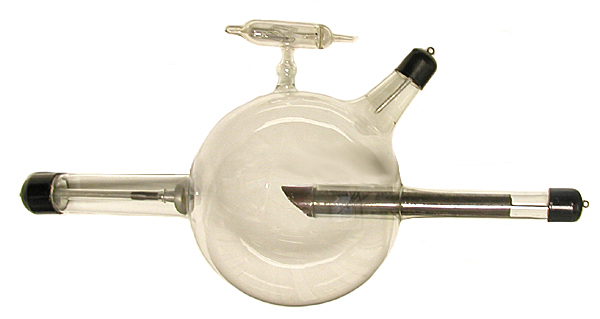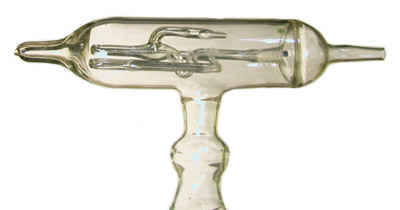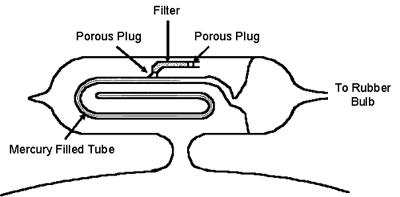Tube with Bauer Regulator (ca. 1912-1915)

This large example of bi-anode tube has no markings that might identify the manufacturer, but it is a safe guess that it is of European origin. The tube was purchased from a dealer in the U.K., it employs a regulator of German design, and the black caps at the ends of the glass arms were typical of tubes made in Europe. Perhaps the most likely manufacturer was the Heinz Bauer company since they held the patent on the rather unique regulator employed by this tube.
What markings there are: "2051" stamped on the target, and "1441" etched on the glass arm housing the cathode.
In the photo, the aluminum cathode is located at the point where its enclosing glass arm attaches to the left side of the spherical bulb.
The anode is the aluminum rod seen inside the glass arm attached to the upper right side of the bulb.
The anticathode, with the copper-jacketed target at its free end, enters the bulb from the glass arm on the right. The target is embedded in the sloped face of the copper “jacket.” I suspect that the target is platinum because manufacturers licensed by Siemens to employ a tungsten target were expected to acknowledge Siemens somewhere on the tube.
A black metal tube, connected to the copper jacket around the target, extends most of the way along the glass arm on the right side of the bulb. Its purpose was to cool the target by radiating heat.
Although it is a little hard to see, there is a glass mantle that surrounds the metal tube and copper block. It extends the entire length of the anticathode inside the bulb with the exception of the target face. One possible function of the mantle: it prevented stray electrons from striking the side of the anticathode and producing X-rays. If X-rays were emitted from more locations than just the target, the resulting X-ray images would be blurry. Another possible function, suggested by Ronne and Nielsen, is that the static charge that would accumulate on the mantle would minimize the unwanted emission of electrons from the target (anticathode) during periods of reverse current.

I have to say, the Bauer regulator seen in the photo to the right is really neat! First described in the January 1907 issue of the Journal of the Rontgen Society, its job was to "soften" the X-rays by increasing the pressure of the gas inside the tube. Most regulators did this by heating a material (e.g., potash or mica) that contained a trapped gas. However, the Bauer regulator controlled the pressure with a mercury valve.
When the pressure inside the tube became too low, a rubber bulb would be connected to the opening on the right end of the regulator (as seen in the photo).

Squeezing the bulb pushed a column of mercury down a narrow glass tube so that a small opening in the tube, normally covered by mercury, was uncovered. When the opening was uncovered, it would allow a little air to enter the tube. Simple.
The diagram to the right (after Kaye) shows the innards of the regulator a little better that the photo.
A nice thing about the Bauer regulator was that it could be operated at a distance. This helped minimize the exposure to the operator.
Size: Approximately 7.5" diameter bulb, 21" long
References
- GWC Kaye. X-Rays. Longmans, Gree and Co. London. 1929.
- H. Bauer. Improvements in Regenerative Devices for Apparatus for Producing Rontgen Rays. British Patent. No. 15,171. December 1912. (Patent kindly provided by Prof. Jean-Francois Loude).
